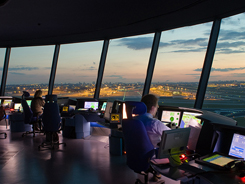Air Traffic Control Career Overview
 Imagine yourself trying to direct 260 tons of metal filled with both passengers and cargo through the middle of a storm. Air Traffic Controllers are responsible for the extremely important task of managing the safe and efficient flow of air traffic throughout the nation’s airspace. They navigate the airways by helping pilots maintain safe separation between their planes, find their way through fog and rough weather, and land safely at busy airports across the world. They also coordinate flights to prevent accidents and minimize delays in takeoffs and landings.
Imagine yourself trying to direct 260 tons of metal filled with both passengers and cargo through the middle of a storm. Air Traffic Controllers are responsible for the extremely important task of managing the safe and efficient flow of air traffic throughout the nation’s airspace. They navigate the airways by helping pilots maintain safe separation between their planes, find their way through fog and rough weather, and land safely at busy airports across the world. They also coordinate flights to prevent accidents and minimize delays in takeoffs and landings.
The Federal Aviation Administration (FAA), the Department of Defense (DOD), and federal and private contract towers employ Air Traffic Controllers. Controllers can be found working in three basic specialties: Air Traffic Control Towers, Terminal Radar Approach Controls, and En Route Centers. Airport Tower Controllers are responsible for regulating airport traffic. They use two-way radios to give pilots permission to take off and land. They also direct ground traffic which includes taxiing aircraft, emergency vehicles, and airport workers. Tower controllers direct air traffic within approximately five miles from the airport.
Airport tower controllers or terminal controllers watch over all planes traveling through the airport’s airspace. Their main responsibility is to organize the flow of aircraft into and out of the airport. Relying on radar and visual observation, they closely monitor each plane to ensure a safe distance between all aircraft and to guide pilots between the hangar or ramp and the end of the airport’s airspace. In addition, controllers keep pilots informed about changes in weather conditions such as wind shear, which is a sudden change in the velocity or direction of the wind that can cause the pilot to lose control of the aircraft.
During arrival or departure, several controllers direct each plane. As a plane approaches an airport, the pilot radios ahead to inform the terminal of the plane’s presence. The controller in the radar room just beneath the control tower has a copy of the plane’s flight plan and has already observed the plane on radar. If the path is clear, the controller directs the pilot to a runway; if the airport is busy, the plane is fitted into a traffic pattern with other aircraft waiting to land. As the plane nears the runway, the pilot is asked to contact the tower. There, another controller, who also is watching the plane on radar, monitors the aircraft the last mile or so to the runway, delaying any departures that would interfere with the plane’s landing. Once the plane has landed, a ground controller in the tower directs it along the taxiways to its assigned gate. The ground controller usually works entirely by sight, but may use radar if visibility is very poor.
The procedure is reversed for departures. The ground controller directs the plane to the proper runway, then the local controller informs the pilot about conditions at the airport such as weather, the speed and direction of wind, and visibility. The local controller also issues runway clearance for the pilot to take off. Once in the air, the plane is guided out of the airport’s airspace by the departure controller.
We hope you have enjoyed our Air Traffic Control Career Overview, Become an Air Traffic Controller today.
(NOTE: The following links will take you to atcsim.nasa.gov link.)
